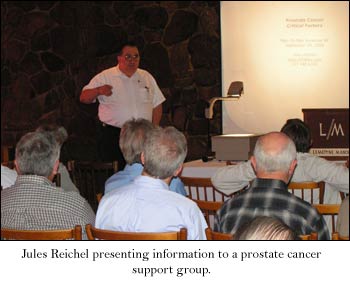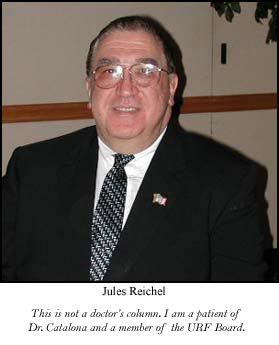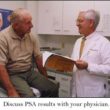Surgery Plus Radiation When Required Offers an Almost Universal Approach for the PSA Era
One Man to Another
Surgery plus radiation when required offers an almost universal approach for the PSA era
(The precedent-setting study of Dr. Michael Bolla)
This is not a doctors column. I am a patient of Dr. Catalona and a member of the URF Board.
A Universal Approach
The goals for treating prostate cancer are to achieve long-term remission, and to return patients to a positive life, largely as before, regardless of the medical situation at diagnosis. This ability to respond effectively to all cases in the PSA era (i.e. assuming early diagnosis) is what I have called a universal approach.
Several prior Quest articles discussed recent improvements in successful treatment of prostate cancer that are based on earlier detection, on lowering the PSA threshold to 2.5ng/ml, and on the use of PSA velocity and doubling time (PSAV/PSAD) to determine the severity of the disease and the best time to begin treatment.
Even though these recent practices have improved rates of good outcome, the average rates of achieving long-term non-recurrence for all patients have been lower than desired. Rates of recurrence over 10-15 year periods of 20%-35% are currently common, and much higher rates of recurrence are common for high-risk cancers.
While recurrence does not always imply later death from prostate cancer, it is a threatening event for the patient because it implies increased risk of metastasis (spread of the cancer) with a lot of additional trouble.
A patient diagnosed with prostate cancer is faced with the risk that his original diagnosis may suggest likely recurrence, or his post-surgery pathology report may suggest likely recurrence, or recurrence may appear unexpectedly many years after treatment. A patient enters treatment hoping that after he is treated, nothing further will ever have to be done. Being told of more trouble with uncertain outcomes is the beginning of another worrisome journey.
Conventional Response to Recurrence
The response to recurrence has not often been radiation therapy as the title for this article suggests, because it has not been viewed as reliable.
Overwhelmingly, the choice has been to use hormonal, (androgen deprivation therapy) ADT. While there are important benefits from using ADT for some cases, there are also adverse effects from long-term use that should not be forgotten. They include: decreased libido, erectile dysfunction, hot flashes, osteopenia (decrease in bone density) with increased fracture risk, gynecomastia (female breast development), metabolic alterations, and changes in cognition and mood.
ADT remains an important therapy, but it has difficult side effects, and it is not usually viewed as being a cure.
Bollas Precedent-Setting Study
In August 2005, Dr. Michael Bolla, who practices in France, reported on a precedent-setting study that appears to have overturned many of the long-held beliefs concerning proper use of radiation therapy as the follow-up to recurrence after surgical treatment (prostatectomy).
Bolla limited his study to high-risk patients whose initial treatment had been surgery. All patients had one or more poor clinical features including: high PSA level before surgery (average 12.3ng/ml), extracapsular extension, positive surgical margins, and seminal vesicle invasion. Such patients would be expected to have high rates of recurrence. All patients were treated as soon as possible (adjuvant treatment) after surgery (90 days) (Others say that only half of that delay for healing is required), with a radiation dose that was low by best American practice (60Gy vs. over 70Gy in the U.S.).
Nevertheless, 74% of the men did not recur in 5 years.
If this work had been performed using 2004 US National Comprehensive Cancer Network (NCCN) guidelines for surgery, and US best practices for radiation dosage were used, one would anticipate 5-year non-recurrence rates for these high risk cases in the 90% range.
If low risk cancer cases can be treated with surgery alone, and medium risk cases or later random recurrences can be treated with surgery and salvage radiation therapy (treatment after a rise in PSA), and high risk cases can be treated with surgery and adjuvant radiation therapy as done by Bolla, then a very broad range of men can be told: With surgery alone or with a combination of surgery and follow-up radiation, we have high confidence that you can be returned to life largely as before. Such therapy can be done with no use, or brief use, of ADT therapies.
Many patients are already selecting treatment that follows from this new research.
The rules for when to use salvage radiation therapy or adjuvant radiation therapy are not yet viewed as medically settled. An important, unanswered question relates to men with a minimally adverse pathology report, such as a focally (tiny) positive surgical margin or focal extracapsular tumor extension with a negative (clear) surgical margin. Is adjuvant radiation therapy better than monitoring the PSA level and then having salvage radiation therapy only if the PSA rises? Studies are currently underway to answer this question, and Dr. Catalona will report the results in Quest when they are available.

Questions and Answers
Q#1: Does this new work mean that everyone should use surgery and radiationwhen required?
ANS: No. Any treatment that a man prefers and works for him is surely a good treatment, and no treatment is suitable for everyone. The approach to treatment suggested here is only for a patient who wishes to consider what can happen if his primary therapy fails. Its much like a policeman having a second bullet in his gun, or a back-up plan if the first strategy fails. The odds of long-term success are greatly improved.
Q#2: Is this combining of surgery and radiation a new idea?
ANS: No. The possibility of such an approach has been evaluated for at least a decade, but Bollas study is the first time that solid evidence of the success of such a procedure has been offered. In Dr. Catalonas 1999 study of his series of 1778 patients, using radiation follow-up available in those earlier years, salvage therapy (after a rise in PSA) was successful 68% of the time during 15-47 months of follow-up, and adjuvant therapy (as soon as possible after surgery) was successful only 33% of the time during 8-56 months of follow-up. Bollas work is a logical progression from prior studies, but now better radiation methods are available.
Q#3: Must we still be concerned with the PSA threshold of 2.5ng/ml for initial treatment?
ANS: YES. Lowering the PSA threshold to 2.5ng/ml provides great benefit and helps avoid recurrence in the first place. It reduces the tumor volume, lowers the stage (extent) of the disease, reduces the Gleason Score, extends the time to recurrence if it will occur, and reduces the rate of recurrence.
Q#4: Is this approach available for me?
ANS: Maybe. In a previous Quest, Dr. Catalona wrote about Stephensons 4-year radiation follow-up study (2004) , pointed out some confusions in this study, but concluded, If Stephenson is correct, some patients with recurring prostate cancer can be optimistic that postoperative radiotherapy might, at least, postpone the spread of CaP.
I suggested that patients discuss this option with their doctors rather than immediately choosing hormonal therapy. Some men reported that they had outstanding success. Their radiation oncologists were already experienced in doing such procedures and were getting very good results. Others reported that their radiation oncologist said that these were new, risky ideas that they would not use on their patients at this time.
These different reactions from doctors are a common issue with new changes in treatment.
Q#5: Whats your own bottom line Jules, as a fellow patient?
ANS: Medical decisions are personal and difficult. For myself, and only for me, I believe that the best of our doctors are making rapid progress in the fight against prostate cancer. I believe a doctor when he tells me that a procedure is risky for him to do. On the other hand, I have seen many men helped by the exceptional care of doctors who use the latest information and treatments to help prostate cancer patients. I dont think that standing by the side and waiting for some ultimate proof is the best option. It is my responsibility to become highly informed, but then it is my obligation to act with courage.
Feedback
Feedback is encouraged. Contact Dr. Catalona at his Website: www.drcatalona.com or send me an e-mail at jules105@aol.com. To see my prior articles, go to the Website and click on Quest Articles. Then scan down and click below my picture.








